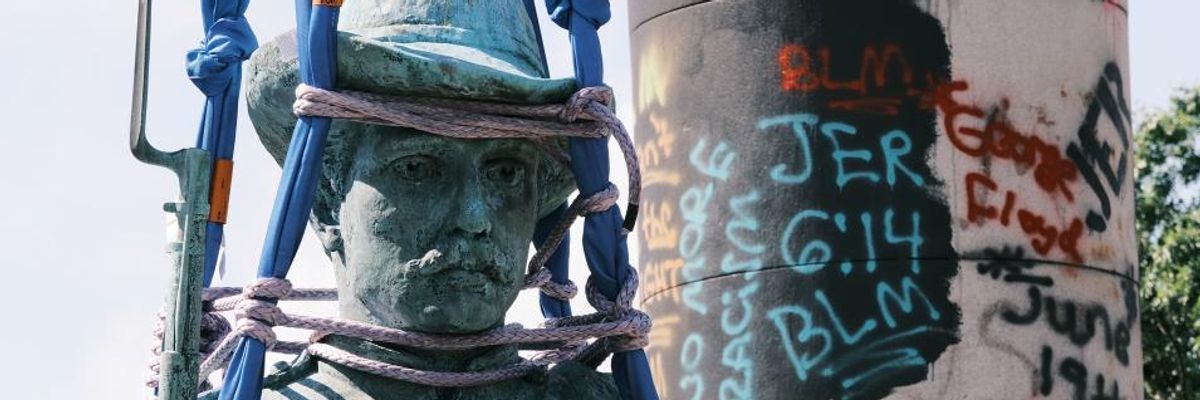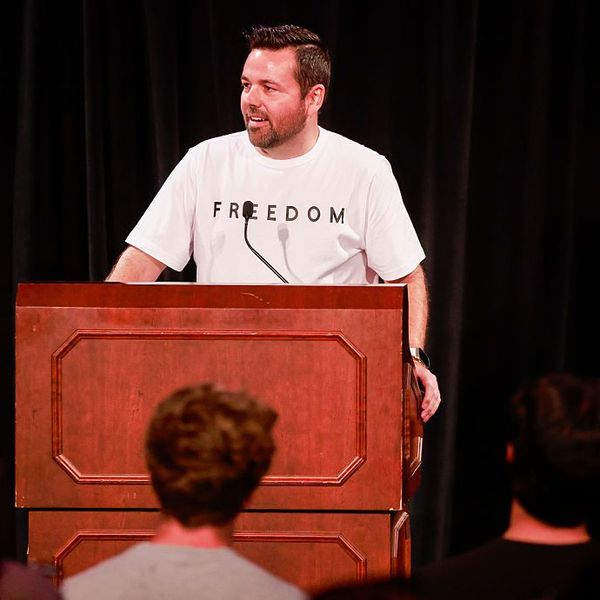
The Confederate soldiers and sailors statue is hoisted down to the ground by a crane on July 8, 2020 in Richmond, Virginia. The vast majority of monuments recently removed were erected decades after the 1865 dissolution of the Confederacy, note the organizers behind the new mapping project, and "served as a means of racist intimidation in a period when Black people had gained expanded political, social, and economic freedoms" in the South. (Photo by Eze Amos/Getty Images)
New Interactive Map Details 67 Confederate Monuments (and Counting) Removed Since George Floyd Murder
"These statues stood as a reminder to Black and brown people of white supremacy and injustice long after the physical chains of slavery. By tearing them down, we're sending a message about our communities' needs. We ask, which side are you on?"
A community organizing group dedicated to racial justice released Friday a new interactive map detailing the location and background of the nearly 70 monuments in former Confederate states that have been taken down, renamed, or removed since the police murder of George Floyd earlier this year.
Created by the Southern Vision Alliance (SVA), which organizes youth and others around issues of justice in the U.S. South, the new map shows where 67 monuments and building titles have been altered or removed since Floyd's killing on May 25 by police officers in Minneapolis. The brutal murder, caught on video by bystanders, helped trigger sparked a nationwide uprising, international outrage, and a fresh reckoning with the racist history of slavery and subjugation of Black people and communities.
According to a statement by the group:
On average, the fallen monuments to the Confederacy were erected 52 years after the Confederate surrender. The entirety of the removed racist memorials stood for an average of 94 years.
In many cases, as with the Jefferson Davis statue in Richmond, Virginia, protesters have brought down the racist memorials themselves. In other cases, as with the Spirit of the Confederacy Monument in Houston, Texas, community organizing has pressured local governments into taking action. This unprecedented moment follows a series of removals and renamings across the South in the wake of white supremacist violence in Charlottesville in August 2017.
The vast majority of these monuments were erected decades after the 1865 dissolution of the Confederacy. They served as a means of racist intimidation in a period when Black people had gained expanded political, social, and economic freedoms.
Of the 67 monuments detailed on the map--all of them in former Confederate states--46 were of Confederate soldiers or leaders. The other monuments detailed include 10 buildings that have been renamed, six statues categorized as "racist," four depictions of Christopher Columbus, and--at the Mississippi state capitol building--the removal of the Confederate flag. The group said the map will be updated as new monuments are removed.
Citing data from the Southern Poverty Law Center's "Whose Heritage?" project, SVA notes that more than 1,700 similar monuments and statues remain standing across the country, though many are receiving fresh scrutiny by community members.
While critical observers have noted the political limits of the movement to topple and remove such monuments, Jess Jude, SVA's Solidarity Hub Coordinator and an activist who faced criminal charges related to the 2017 toppling of a Confederate soldier statue in Durham, North Carolina, said the trend is not just about the racism of the past but also the injustices of the present.
"These statues stood as a reminder to Black and brown people of white supremacy and injustice long after the physical chains of slavery," said Jude. "By tearing them down, we're sending a message about our communities' needs. We ask, which side are you on?"
An Urgent Message From Our Co-Founder
Dear Common Dreams reader, The U.S. is on a fast track to authoritarianism like nothing I've ever seen. Meanwhile, corporate news outlets are utterly capitulating to Trump, twisting their coverage to avoid drawing his ire while lining up to stuff cash in his pockets. That's why I believe that Common Dreams is doing the best and most consequential reporting that we've ever done. Our small but mighty team is a progressive reporting powerhouse, covering the news every day that the corporate media never will. Our mission has always been simple: To inform. To inspire. And to ignite change for the common good. Now here's the key piece that I want all our readers to understand: None of this would be possible without your financial support. That's not just some fundraising cliche. It's the absolute and literal truth. We don't accept corporate advertising and never will. We don't have a paywall because we don't think people should be blocked from critical news based on their ability to pay. Everything we do is funded by the donations of readers like you. Will you donate now to help power the nonprofit, independent reporting of Common Dreams? Thank you for being a vital member of our community. Together, we can keep independent journalism alive when it’s needed most. - Craig Brown, Co-founder |
A community organizing group dedicated to racial justice released Friday a new interactive map detailing the location and background of the nearly 70 monuments in former Confederate states that have been taken down, renamed, or removed since the police murder of George Floyd earlier this year.
Created by the Southern Vision Alliance (SVA), which organizes youth and others around issues of justice in the U.S. South, the new map shows where 67 monuments and building titles have been altered or removed since Floyd's killing on May 25 by police officers in Minneapolis. The brutal murder, caught on video by bystanders, helped trigger sparked a nationwide uprising, international outrage, and a fresh reckoning with the racist history of slavery and subjugation of Black people and communities.
According to a statement by the group:
On average, the fallen monuments to the Confederacy were erected 52 years after the Confederate surrender. The entirety of the removed racist memorials stood for an average of 94 years.
In many cases, as with the Jefferson Davis statue in Richmond, Virginia, protesters have brought down the racist memorials themselves. In other cases, as with the Spirit of the Confederacy Monument in Houston, Texas, community organizing has pressured local governments into taking action. This unprecedented moment follows a series of removals and renamings across the South in the wake of white supremacist violence in Charlottesville in August 2017.
The vast majority of these monuments were erected decades after the 1865 dissolution of the Confederacy. They served as a means of racist intimidation in a period when Black people had gained expanded political, social, and economic freedoms.
Of the 67 monuments detailed on the map--all of them in former Confederate states--46 were of Confederate soldiers or leaders. The other monuments detailed include 10 buildings that have been renamed, six statues categorized as "racist," four depictions of Christopher Columbus, and--at the Mississippi state capitol building--the removal of the Confederate flag. The group said the map will be updated as new monuments are removed.
Citing data from the Southern Poverty Law Center's "Whose Heritage?" project, SVA notes that more than 1,700 similar monuments and statues remain standing across the country, though many are receiving fresh scrutiny by community members.
While critical observers have noted the political limits of the movement to topple and remove such monuments, Jess Jude, SVA's Solidarity Hub Coordinator and an activist who faced criminal charges related to the 2017 toppling of a Confederate soldier statue in Durham, North Carolina, said the trend is not just about the racism of the past but also the injustices of the present.
"These statues stood as a reminder to Black and brown people of white supremacy and injustice long after the physical chains of slavery," said Jude. "By tearing them down, we're sending a message about our communities' needs. We ask, which side are you on?"
A community organizing group dedicated to racial justice released Friday a new interactive map detailing the location and background of the nearly 70 monuments in former Confederate states that have been taken down, renamed, or removed since the police murder of George Floyd earlier this year.
Created by the Southern Vision Alliance (SVA), which organizes youth and others around issues of justice in the U.S. South, the new map shows where 67 monuments and building titles have been altered or removed since Floyd's killing on May 25 by police officers in Minneapolis. The brutal murder, caught on video by bystanders, helped trigger sparked a nationwide uprising, international outrage, and a fresh reckoning with the racist history of slavery and subjugation of Black people and communities.
According to a statement by the group:
On average, the fallen monuments to the Confederacy were erected 52 years after the Confederate surrender. The entirety of the removed racist memorials stood for an average of 94 years.
In many cases, as with the Jefferson Davis statue in Richmond, Virginia, protesters have brought down the racist memorials themselves. In other cases, as with the Spirit of the Confederacy Monument in Houston, Texas, community organizing has pressured local governments into taking action. This unprecedented moment follows a series of removals and renamings across the South in the wake of white supremacist violence in Charlottesville in August 2017.
The vast majority of these monuments were erected decades after the 1865 dissolution of the Confederacy. They served as a means of racist intimidation in a period when Black people had gained expanded political, social, and economic freedoms.
Of the 67 monuments detailed on the map--all of them in former Confederate states--46 were of Confederate soldiers or leaders. The other monuments detailed include 10 buildings that have been renamed, six statues categorized as "racist," four depictions of Christopher Columbus, and--at the Mississippi state capitol building--the removal of the Confederate flag. The group said the map will be updated as new monuments are removed.
Citing data from the Southern Poverty Law Center's "Whose Heritage?" project, SVA notes that more than 1,700 similar monuments and statues remain standing across the country, though many are receiving fresh scrutiny by community members.
While critical observers have noted the political limits of the movement to topple and remove such monuments, Jess Jude, SVA's Solidarity Hub Coordinator and an activist who faced criminal charges related to the 2017 toppling of a Confederate soldier statue in Durham, North Carolina, said the trend is not just about the racism of the past but also the injustices of the present.
"These statues stood as a reminder to Black and brown people of white supremacy and injustice long after the physical chains of slavery," said Jude. "By tearing them down, we're sending a message about our communities' needs. We ask, which side are you on?"

